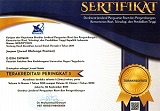Analysis of differences in lay-up shoot ability from the right and left sides of men's basketball extracurricular members
DOI:
https://doi.org/10.21831/jorpres.v19i3.66756Keywords:
Differences, lay up shoot, right side, left side, basketballAbstract
The problem in this research is that students are not yet perfect at doing lay-up shoots in both position and movement. This research aims to determine the difference in ability between lay-up shoots from the right side and the left side among boys' basketball extracurricular members aged 11-14 years. This research is a descriptive study using a survey method. The sample in this study was taken by random sampling, totaling 30 students. The instrument of this research is the lay-up shoot test modified. Data collection techniques using test and measurement methods. Data analysis using prerequisite tests and t-tests. The statistical test results showed that the lay-up shoot t-test value on the right and left sides had a calculated t of -1.193 and the t-table value with df 14 at the 5% significance level was 2.14. p = 0.253, because p > 0.05 there is no significant difference. So it can be concluded that there is no significant difference between lay-up shots from the right side and the left side for boys' basketball extracurricular members aged 11-14 years
References
Betty Retnowulan, R. R., & Kunta Purnama, S. (2017). The contribution of body height, arm length, arm muscle strength and leg power on the ability of free throw shoot of woman basketball athletes. European Journal of Physical Education and Sport Science , 3(3), 79–96. https://doi.org/10.5281/zenodo.438121.
Conte, D., Favero, T. G., Lupo, C., Francioni, F. M., Capranica, L., & Tessitore, A. (2015). Time-motion analysis of italian elite women's basketball games: Individual and team analyses. Journal of Strength and Conditioning Research, 29(1), 144–150. https://doi.org/10.1519/JSC.0000000000000633.
Csataljay, G., James, N., Hughes, M., & Dancs, H. (2012). Performance differences between winning and losing basketball teams during close, balanced and unbalanced quarters. Journal of Human Sport and Exercise, 7(SPECIALISSUE.2), 356–364. https://doi.org/10.4100/jhse.2012.72.02
Donovan, M. (2010). 101 youth basketball drills. A&C Black..pdf. (n.d.).
Gaetano, R., Gaetano, A., Domenico, T., & Mario, L. (2016). Analysis of learning a basketball shot. Journal of Physical Education and Sport, 16(1), 3–7. https://doi.org/10.7752/jpes.2016.01001.
Hardhina, O. (2022). Exercise Modification To Enhance Layup Shoot Abilities in Basketball Games. International Journal of Basketball Studies, 1(1), 17–24. https://doi.org/10.31949/ijobs.v1i1.3726.
Hastuti, T. A. (2008). Kontribusi Ekstrakurikuler Bolabasket Terhadap Pembimbitan Atlet dan Peningkatan Kesegaran Jasmani. Pendidikan Jasmani Indonesia, 5(1), 45–50.
Ibáñez, S. J., García, J., Feu, S., Lorenzo, A., & Sampaio, J. (2009). Sergio J. Ibáñez.pdf. July, 458–462.
In, D. I., Evel, E. L., Bdelkrim, N. I. B. E. N. A., Haouachi, A. N. I. S. C., Hamari, K. A. C., & Htara, M. O. C. (2010). P r c -l d e -l m b p. 1346–1355.
Lorenzo, A., Gómez, M. í., Ortega, E., Ibáñez, S. J., & Sampaio, J. (2010). Game related statistics which discriminate between winning and losing under-16 male basketball games. Journal of Sports Science and Medicine, 9(4), 664–668.
McCormick, B. (2014). the Relationship Between Lateral Movement and Power in Female Adolescent Basketball Play. Arena-Journal of Physical Activities, 0(3), 13–26. https://www.uav.ro/jour/index.php/ajpa/article/view/421.
Nunes, H., Iglesias, X., Del Giacco, L., & Anguera, M. T. (2022). The Pick-and-Roll in Basketball From Deep Interviews of Elite Coaches: A Mixed Method Approach From Polar Coordinate Analysis. Frontiers in Psychology, 13(March). https://doi.org/10.3389/fpsyg.2022.801100.
Putro, K. H., Siswantoyo, & Aman, M. S. (2020). Analysis of Effects of Service Quality and Loyalty on Interest Rates of Basketball Athletes in Sahabat Basketball Club Yogyakarta. HOLISTICA – Journal of Business and Public Administration, 11(2), 151–160. https://doi.org/10.2478/hjbpa-2020-0025.
Supervisor, S., & Conte, D. (2021). Master Degree Program Of International Basketball Coaching Basketball Shot Typologies In Men And Women ' S Euroleague Confirmation Of Liability For The Regularity Of The Lithuanian / Foreign Language Final Master ' S Thesis Supervisor ' S Assessment.
Till, K., Jones, B. L., Cobley, S., Morley, D., O'Hara, J., Chapman, C., Cooke, C., & Beggs, C. B. (2016). Identifying talent in youth sport: A novel methodology using higher-dimensional analysis. PLoS ONE, 11(5), 1–18. https://doi.org/10.1371/journal.pone.0155047.
Tomas, J. P. Q., Lucero, K. I., Ajero, C. J. P., & Thomas, R. J. V. (2023). Comparative Study on Model Skill of ERT and LSTM in Classifying Proper or Improper Execution of Free Throw, Jump Shot, and Layup Basketball Maneuvers. Journal of Advances in Information Technology, 14(3), 594–600. https://doi.org/10.12720/jait.14.3.594-600.
Torres-Unda, J., Zarrazquin, I., Gil, J., Ruiz, F., Irazusta, A., Kortajarena, M., Seco, J., & Irazusta, J. (2013). Anthropometric, physiological and maturational characteristics in selected elite and non-elite male adolescent basketball players. Journal of Sports Sciences, 31(2), 196–203. https://doi.org/10.1080/02640414.2012.725133.
Ward, P., Hodges, N. J., Starkes, J. L., & Williams, M. A. (2007). The road to excellence: Deliberate practice and the development of expertise. High Ability Studies, 18(2), 119–153. https://doi.org/10.1080/13598130701709715.
Downloads
Published
How to Cite
Issue
Section
License
Authors who publish with this journal agree to the following terms:
- Authors retain copyright and grant the journal right of first publication with the work simultaneously licensed under a Creative Commons Attribution License that allows others to share the work with an acknowledgement of the work's authorship and initial publication in this journal.
- Authors are able to enter into separate, additional contractual arrangements for the non-exclusive distribution of the journal's published version of the work (e.g., post it to an institutional repository or publish it in a book), with an acknowledgement of its initial publication in this journal.
- Authors are permitted and encouraged to post their work online (e.g., in institutional repositories or on their website) prior to and during the submission process, as it can lead to productive exchanges, as well as earlier and greater citation of published work (See The Effect of Open Access).




